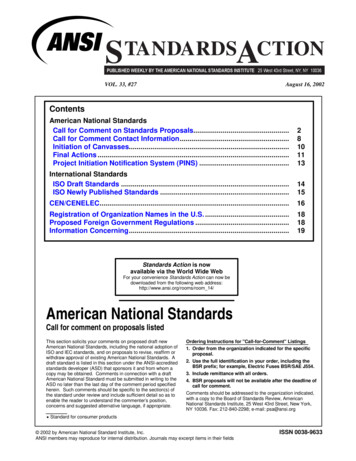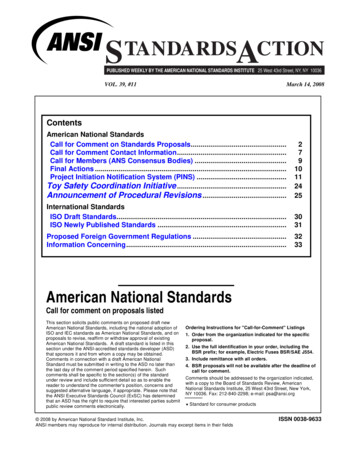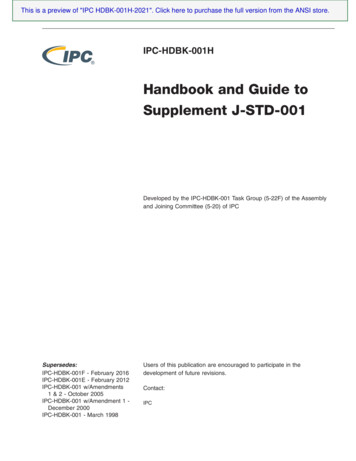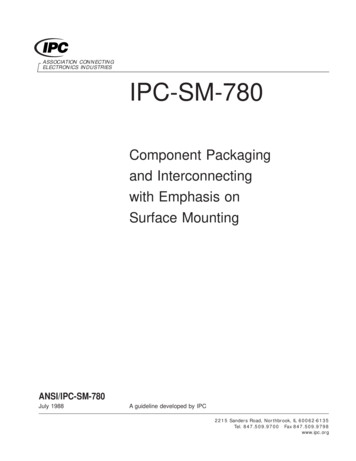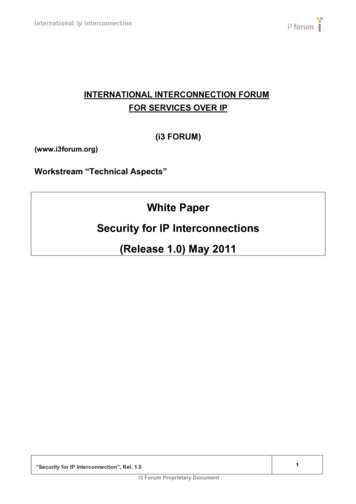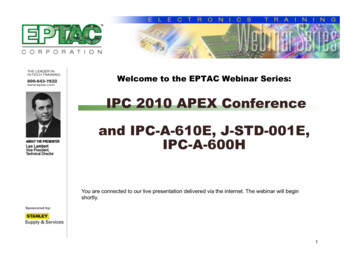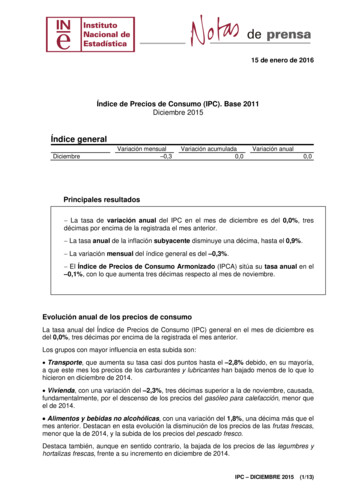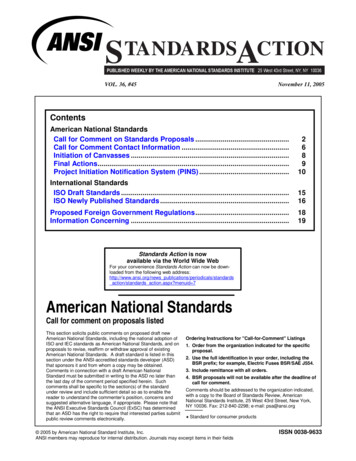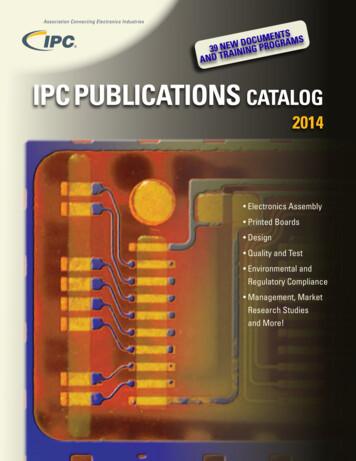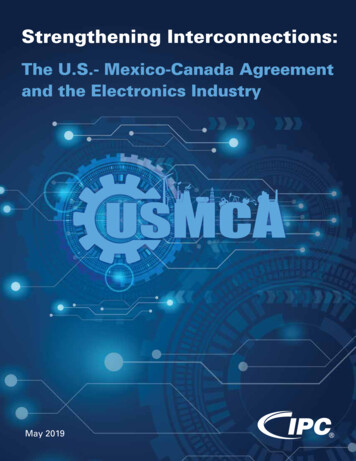
Transcription
Strengthening Interconnections:The U.S.- Mexico-Canada Agreementand the Electronics IndustryMay 2019
May 2019Table of ContentsAbout This Report . . . . . . . . . . . . . . . . . . . . . . . . . . . . . . . . . . . . . . . . iForeword . . . . . . . . . . . . . . . . . . . . . . . . . . . . . . . . . . . . . . . . . . . . . iiExecutive Summary . . . . . . . . . . . . . . . . . . . . . . . . . . . . . . . . . . . . . . . 1Introduction . . . . . . . . . . . . . . . . . . . . . . . . . . . . . . . . . . . . . . . . . . . 2Economic Analysis: A Positive Overall Impact . . . . . . . . . . . . . . . . . . . . . . . . 4Effects on Supply Chain Optimization . . . . . . . . . . . . . . . . . . . . . . . . . . . . 5Effects on Intra-Firm Trade in Electronics . . . . . . . . . . . . . . . . . . . . . . . . . . 6Measuring Value Added Content of Manufacturing . . . . . . . . . . . . . . . . . . . . 8Effects on Printed Circuit Board Manufacturers . . . . . . . . . . . . . . . . . . . . . .11Effects on Electronics Manufacturing Service Providers . . . . . . . . . . . . . . . . . 13Key Elements of USMCA and their Relevance to the Electronics Sector . . . . . . . . . .14USMCA Creates New Opportunities for Small and Medium Enterprises . . . . . . . . 14USMCA Will Promote the Expansion of Digital Services . . . . . . . . . . . . . . . . .15USMCA Strengthens Intellectual Property Protection . . . . . . . . . . . . . . . . . . .16The Sunset Clause Injects Long-Term Uncertainty . . . . . . . . . . . . . . . . . . . . 16USMCA Automotive Rules Create Uncertainties for Electronics Sector . . . . . . . . .17USMCA Strengthens Labor Requirements . . . . . . . . . . . . . . . . . . . . . . . . .18Conclusion . . . . . . . . . . . . . . . . . . . . . . . . . . . . . . . . . . . . . . . . . . . .19
Strengthening Interconnections: The U.S.- Mexico-Canada Agreement and the Electronics IndustryAbout This ReportThe purpose of this report is to provide an independent, informational, and analytical resource that describesthe potential impacts of the proposed U.S.-Mexico-Canada Agreement (USMCA) on the U.S. and globalelectronics industry.IPC — Association Connecting Electronics Industries (www.IPC.org) commissioned this report to be written byShawn DuBravac, PhD, CFA, president and founder of Avrio Institute (https://avrioinstitute.org), which providesconsulting, research and advisory services to clients on topics including digital transformation, business modeldisruptions, and the pace of technological change. For more than a dozen years, Dr. DuBravac served as chiefeconomist for the Consumer Technology Association (CTA), the U.S. trade association representing more than2,000 consumer tech companies.Readers interested in further information about the electronics industry and its views on the USMCA may contactChris Mitchell, IPC Vice President of Global Government Relations, via the IPC website (www.ipc.org/advocacy).IPC also thanks Casie Daugherty of Prime Policy, Dale Curtis of Dale Curtis Communications, and our IPCcolleagues Sandy Gentry and Irina Gelman for their invaluable assistance.i
May 2019ForewordOver the 22 years I represented Tennessee’s 8th Congressional District, party affiliation was a strongindicator of my colleagues’ views on trade. Republicans largely backed free trade agreements, whileDemocrats mostly opposed them. As a founder of the conservative Democratic Blue Dog Caucus, Ijoined an informal coalition of about two dozen Democrats and most Republicans to support fasttrack negotiating procedures and the trade agreements they produced.Since I retired from Congress in 2011, the politics of trade have turned against those who supporttrade liberalization. The 2008 financial crisis, the ensuing recession, and a long, slow recoveryamplified fears that the global economic order had advanced the interests of the few at the expenseof the many.In the 2016 presidential campaign, Republican Donald Trump voiced the pain of those millionswho felt economically marginalized, and Democrat Hillary Clinton sided with them as well. Thetwo candidates opposed the Trans-Pacific Partnership and the Transatlantic Trade and InvestmentPartnership that were both close to completion. As a strong advocate for U.S. leadership in the world,I regretted the U.S. withdrawal from these trade agreements.Today, the politics of trade are scrambled as never before. A 2018 survey by the Brookings Institutionfound that 37% of Republicans believed trade destroys U.S. jobs, while only 22% of Democrats saidthe same.I believe this moment is an opportunity to modernize our trade relationships and rebuild the nationalconsensus on trade. Indeed, the argument has been mischaracterized as a political issue, when infact it is about our plain economic interests. For over a century, the United States has been able togrow more food and manufacture more products than we can sell domestically. If the rules breakdown on how to sell U.S. goods abroad, someone is going to lose their job.In the context of this report, any serious effort to revitalize American manufacturing must begin withthe understanding that revitalizing U.S. manufacturing requires strengthening the manufacturingbases in Mexico and Canada as well. U.S. companies have developed sophisticated, integratedsupply chains with their partners to the north and south, and these partnerships have allowed themto maintain their U.S. operations, to preserve and create new jobs, and to better compete in theglobal marketplace. This is especially true for small and medium-sized enterprises.Given these facts, it is critical to maintain a trade agreement that facilitates the region’s economicgrowth. The U.S.-Mexico-Canada Agreement achieves this goal, and that is why many U.S.industries, including IPC, support it. The 116th Congress must seize the opportunity to advance theagreement and with it the prospects of U.S. companies and workers.John TannerU.S. Representative from Tennessee (1989-2011)Former Chairman, House Ways and Means Subcommittee on Tradeii
Strengthening Interconnections: The U.S.- Mexico-Canada Agreement and the Electronics IndustryExecutive Summary IPC — Association Connecting Electronics Industries (www.IPC.org) believes the USMCA is a positivestep for the U.S. and North American electronics sector and should be approved by the U.S. Congress andimplemented by the Executive Branch at the earliest opportunity. Bilateral trade between the United States and its North American counterparts is now six times larger than itwas prior to NAFTA. Many electronics companies have leveraged economic integration across North Americato maintain and grow their U.S. operations. The total value of U.S. electronics trade with Canada and Mexico was 155.5 billion in 2017. Electronics exportsare 31 percent of all U.S. exports of manufactured goods, natural resources and energy exports to Mexico, and18 percent of all U.S. exports of manufactured goods, natural resources and energy exports to Canada. Congressional consideration of USMCA comes amidst worldwide turmoil in traditional trade relationships.These uncertainties underscore the importance of passing USMCA, reducing long-term uncertainties in NorthAmerica, and creating a more conducive environment for physical and human capital investment in the UnitedStates, Mexico and Canada. The role of intra-firm trade is highly influential in North American cross-border flows. Approximately 78 percentof all electronics imported from Mexico and 47 percent of all electronics exported to Mexico are betweenparent companies and their affiliates. Mexico imports 34 percent of U.S. printed circuit board production, making it not only the largest market forU.S. PCBs, but also larger than the next four largest markets combined. Beyond the underlying economics, several specific provisions of USMCA are particularly significant for theelectronics industry:a. The overwhelming majority of U.S. electronics companies are small and medium-sized enterprises, whichmakes the inclusion of an SME chapter significant for the industry.b. Given the growing relationship between the electronics sector and digital services, USMCA’s digital tradechapter could pave the way to unprecedented innovation and investment.c. Protecting intellectual property and trade secrets is fundamental to the success of the electronics industry;USMCA would strengthen IP protection and enforcement.d. USMCA’s sunset clause would create unnecessary uncertainties that could hinder investment.e. Proposed changes in the regional value content requirements for automobiles are a mixed bag.1
May 2019IntroductionMore than 25 years have elapsed since ratification of the North American Free Trade Agreement(NAFTA) by the United States, Mexico and Canada. The agreement was contentious at the time andhas remained a polarizing issue in American politics, but the evidence is clear that NAFTA, broadlyspeaking, has strengthened manufacturing across all three countries. The recently signed U.S.Mexico-Canada Agreement (USMCA) promises to build on this success by positioning the region foreven greater economic growth and integration in the years ahead.NAFTA eliminated most tariffs on products traded between the three countries, lowered technicalbarriers to trade (TBT), established protections for intellectual property and foreign investment, andintegrated side agreements on labor and environment. Since its implementation, U.S. trade with itsNAFTA partners has more than tripled, outpacing the rate of increase in U.S. trade with the rest of theworld. Canada and Mexico today are leading export markets for U.S. goods, including electronics.1The two countries alone purchase one-fifth of all U.S. manufacturing output, totaling more than theU.S.’s next ten trading partners combined.These statistics tell only a small part of the story. A disproportionate share of the trade within NorthAmerica results from the emergence of geographically integrated, vertical supply chains, serving theautomotive, medical, electronics and machinery industries. The flow of intermediate inputs acrossthe U.S.-Mexico border, in particular, has increased dramatically since NAFTA’s implementation.According to some estimates, 40% of the content of U.S. imports from Mexico and 25% of thecontent of U.S. imports from Canada are of U.S. origin. These numbers far outpace other regions ofthe world. U.S. imports from China, for example, have approximately 4% U.S. content.2Many electronics companies have leveraged economic integration across North America to maintain,if not grow, their U.S. operations. Today, the North American electronics supply chain is quitebalanced: In 2016, the U.S. imported a value of 64.9 billion in electronics from NAFTA countriesand exported 67.1 billion.3 The growth of the North American supply chain should be heralded as asuccess story and a critical factor in ongoing efforts to revitalize U.S. electronics manufacturing.Congressional consideration of USMCA is coming amidst a multifaceted effort by the TrumpAdministration to restructure U.S. trade relationships globally; trade policy turmoil within theEuropean Union (i.e. “Brexit”); and even wider geopolitical conflicts and tensions. These elevateduncertainties underscore the importance of passing USMCA this year and solidifying the UnitedStates’ central role in the North American supply chain. Given the desire within industry for “some”certainty amid significant global uncertainties, USMCA would deliver a great deal of positivecertainty, and that current analysis likely understates the positive impacts, given that U.S. electronicscompanies are shifting their supply chains in response to developments in Asia and Europe.M. Angeles Villarreal and Ian Fergusson, “The North American Free Trade Agreement,” Congressional ResearchService, May 24, 2017. https://fas.org/sgp/crs/row/R42965.pdf2Robert Koopman, William Powers, Zhi Wang, and Shang-Jin Wei, “Give Credit Where Credit Is Due: Tracing ValueAdded in Global Production Chains,” NBER Working Paper No. 16426, Cambridge, MA, September 2010, RevisedSeptember 2011.3Statista, “Statista Industry Report: USA: Manufacturing: Computer and Electronics: NAICS 334,” June 2017.12
Strengthening Interconnections: The U.S.- Mexico-Canada Agreement and the Electronics IndustryMoreover, USMCA makes many important updates to NAFTA including a new digital trade chapter, newintellectual property protections, reductions in technical barriers to trade, and new commitments to smalland medium-sized enterprises (SMEs). The electronics industry, however, harbors some concerns about theagreement. Most notably, the sunset clause will inject unnecessary long-term uncertainty into the North Americanmarketplace, while the more restrictive rules-of-origin requirements may increase costs, force modifications ofsupply chains that have been built and optimized over the last 25 years, and incentivize firms to make alternativemanufacturing choices because the associated costs of these changes outweigh benefits to the manufacturer. Thisin turn will hurt consumers with higher costs or limited choice and could make North American manufacturersless globally competitive.Overall, IPC — Association Connecting Electronics Industries (www.IPC.org) believes the USMCA is a positivestep for the U.S. and North American electronics sector and should be approved by the U.S. Congress andimplemented by the Executive Branch at the earliest opportunity.IPC Endorses the U.S.-Mexico-Canada AgreementIPC, a U.S.-based, global industry association representing more than 5,300 member facilities across the 2 trillion electronics industry, has members with deep investments and thousands of employees in theUnited States, Mexico and Canada. As such, we are highly interested in the rules that govern trade andcommerce among the three nations.As the U.S. Congress takes up consideration of the U.S.-Mexico-Canada Agreement (USMCA), whichwould replace the 25-year-old North American Free Trade Agreement (NAFTA), it is important torecognize that building a stronger U.S. electronics industry depends in no small measure on building astronger North American supply chain.The USMCA promises to spur even greater integration among electronics companies and theircustomers across North America and strengthen the region’s stature as a bastion of strength, stability,and jobs growth in an uncertain world.We commissioned this study to better understand the potential impacts of the USMCA on the U.S. andglobal electronics industry. We have concluded that the USMCA is a positive step for the sector andshould be approved by the U.S. Congress.John MitchellPresident and CEOIPC — Association Connecting Electronics Industries (www.IPC.org)3
May 2019Economic Analysis: A Positive Overall ImpactSince the 1990s, trade between the United States and its trading partners Canada and Mexico hasincreased significantly. Bilateral trade in goods today is six times larger than it was prior to thepassage of NAFTA. The United States is the largest export market for both Mexico and Canada;while Canada and Mexico are the #1 and #2 buyers of U.S. goods, respectively.4 Canada and Mexicocollectively receive 34 percent of total U.S. exports.5Total Bilateral Trade With Canada and Mexico 1,200Billions of USD 1,000 800 600 400 820092010201120122013201420152016201718 -Total Bilateral TradeCanadaMe xicoSource: Author’s calculation with data from the U.S. Census BureauElectronics are a key component of trade between the United States, Canada, and Mexico. The totalvalue of U.S. electronics trade with Canada and Mexico was 155.5 billion in 2017.6 This includedU.S. exports of electronics to Mexico and Canada of 45.5 billion and 29.9 billion, respectively.7Moreover, electronics exports are 31 percent of all U.S. exports of manufactured goods, naturalresources and energy exports to Mexico, and 18 percent of all U.S. exports of manufactured goods,natural resources and energy exports to Canada.8The total value of electronics flowing between the United States and its North American tradingpartners is likely much higher because electronics have become a key component of diverse goods.For example, the electronics cost of a new vehicle as a percent of the total cost of the vehicle was inthe single digits until the 1980s. Today, industry estimates suggest electronics represent more than 35percent of the total value of a new vehicle.9Author’s calculation with data from the U.S. Census BureauU.S. International Trade Commission (USITC). U.S.-Mexico-Canada Trade Agreement: Likely Impact on the U.S.Economy and on Specific Industry Sectors. USITC Publication no. 4889. Washington, DC: USITC, 2019. .6Ibid.7Ibid.8Ibid.454
Strengthening Interconnections: The U.S.- Mexico-Canada Agreement and the Electronics IndustryThe ITC analysis estimates that USMCA, when fully implemented and enforced, would raise U.S. real GDP by 68.2 billion (0.35 percent) and create 176,000 U.S. jobs ( 0.12 percent). Overall trade with Canada and Mexicowould increase approximately 65 billion (5 percent). U.S. exports to Canada would grow by 5.9 percent, whileexports to Mexico would grow by 6.7 percent.10Passage of the agreement would also bring indirect benefits that could support economic growth over a muchlonger horizon. NAFTA had already eliminated duties on most qualifying goods and services and reduced manynontariff barriers. As a result, USMCA’s focus is on solidifying these earlier measures and further reducingnontariff barriers on trade. USMCA measures like harmonization of regulation across participating countries andestablishing commitments to opens flows of data should foster a commitment to trade North American trade.Passage of USMCA would remove significant long-term uncertainty and promote investing in North America at atime when there is tremendous uncertainty regarding global growth and international trade.Effects on Supply Chain OptimizationTariffs and other trade barriers may cause firms to produce the same or very similar products in neighboringcountries when it would be more efficient to manufacture them in a single location. NAFTA liberalized NorthAmerican trade and integrated myriad industry sectors across all three countries. This enabled firms in thesesectors to optimize supply chains, lower costs, and improve efficiency. Today supply chains are tightly connectedacross North American borders, and major firms in most sectors are working extensively in all three countries.It is not uncommon for goods to flow back and forth between the United States, Mexico and Canada as part ofthe production process. For example, in some instances auto components cross the borders between the UnitedStates, Canada, and Mexico as many as eight times as a vehicle is being produced.11Electronics manufacturers, like other manufacturers, optimize supply chains based on market dynamics andbusiness environments. Because supply chains represent costs for companies with razor-thin profitability, firmsare constantly seeking to improve supply chain efficiencies. Over the 25 years that NAFTA has been in place,companies have optimized supply chains in order to maximize production performance while minimizing costs.This has made both U.S. companies and consumers better off.At present, the future of North American trade is in doubt, creating uncertainties which – if left unresolved – willdelay North American supply-chain investment at best, and possibly spur companies to redirect investmentto other markets. This would lead to suboptimal supply chain calibration, leaving both U.S. businesses andconsumers worse off. Under this second-best alternative, U.S. companies could face higher costs and lessefficient production, while U.S. consumers could also see higher costs together with fewer product choices.Nelson, Steve (2010). Automotive Market and Industry Update [PowerPoint slides]. Retrieved from /WBNR FTF10 AUT F0747 PDF.pdf10U.S. International Trade Commission (USITC). U.S.-Mexico-Canada Trade Agreement: Likely Impact on the U.S.Economy and on Specific Industry Sectors. USITC Publication no. 4889. Washington, DC: USITC, 2019. .11Robert Pastor, “The Future of North America,” Foreign Affairs, July-August, 2008, p. 89.95
May 2019Because NAFTA eliminated duties on most qualified goods, USMCA’s commitment to retain zerotariffs on qualified goods – together with an emphasis on reducing additional non-tariff barriersand other impediments to trade – will remove uncertainties that could otherwise hinder investmentin North American electronics supply chains. Because manufacturing supply chains often involvelong-lived assets, uncertainty causes U.S. manufacturers to delay or even forgo capital investment.Removing uncertainties is a win for U.S. consumers and businesses. USMCA passage would allowU.S. businesses to continue to leverage supply chains that have been developed and optimized overthe last 25 years. The certainty afforded by USMCA passage also would allow U.S. companies toinvest in mitigating current and future risks.Mexico and Canada’s geographic proximity to the United States, together with duty-free trade underNAFTA, has led to the emergence of manufacturing clusters within all three countries. Within theseclusters, firms often employ similar technologies and share worker skill needs. As a result, as firmsincrease their investments in both physical and human capital in their respective geographic areas,the entire industry supply chain benefits. Moreover, because increasingly specialized skills can beemployed across similar firms, workers maintain flexibility.The North American electronics value chain is heavily integrated, and this integration is likely togrow over the next decade because of manufacturers’ desire to reduce Time-to-Market. ReducingTime-to-Market benefits manufacturers in numerous ways but it is increasingly required in a marketenvironment defined by customers who want to customize products at the time of order but stilldemand rapid delivery.Effects on Intra-Firm Trade in ElectronicsInternational trade can be classified into two broad categories: arm’s-length trade and intra-firmtrade. Arm’s-length trade is between two unaffiliated entities that have no ownership or control inthe other. Intra-firm trade is trade between firms linked by control or ownership, such as betweena parent company and its affiliates abroad.12 Multinational enterprises (MNEs) have played acentral role in globalization over the last two decades by establishing foreign subsidiaries. Today asignificant portion of international trade is the movement of goods between affiliated companies.MNEs transfer factors of production from one country to another as part of often-large networksof manufacturing facilities. U.S. companies today maximize value creation by optimizing globallydispersed production capacity and capabilities.The role of intra-firm trade is highly influential in North American cross-border flows. Approximately45 percent of all imports into the United States are intra-firm imports.13 Roughly 50 percent of importsfrom Canada are intra-firm imports, while 71 percent of all imports from Mexico are goods beingmoved intra-firm.14The United States Census Bureau compiles intra-firm trade data from U.S. customs documentation. Companies arerequired to declare if cross border shipments are between related parties (intra-firm). While answering the question isrequired, importers and exporters do not always provide an answer. The U.S. Census Bureau does not estimate intrafirm trade for declarations that are missing a response. These data are recorded as “nonreported.”13Author’s calculation with data from the U.S. Census Bureau; excludes Mexico and Canada14Author’s calculation with data from the U.S. Census Bureau126
Strengthening Interconnections: The U.S.- Mexico-Canada Agreement and the Electronics IndustryExport data tells a similar story. Roughly 26 percent of U.S. exports to all countries outside of Mexico and Canadaare intra-firm exports. Approximately 40 percent and 42 percent of exports to Canada and Mexico are intra-firmtrade flows, respectively.15Share of Total Intra-firm otal (Ex MEX, CAN)2014Me x i c o20152016CanadaSource: Author’s calculation with data from the U.S. Census BureauShare of Total Intra - firm al (Ex MEX, CAN)2013Me x i c o201420152016CanadaSource: Author’s calculation with data from the U.S. Census BureauWithin the computer and electronics product manufacturing sector (NAICS code 334), intra-firm trade betweenthe U.S. and Mexico is significant. Approximately 78 percent of all electronics imported from Mexico and 47percent of all electronics exported to Mexico are between parent companies and their affiliates.161516Ibid.Ibid.7
May 2019Intra-firm Electronics Trade with 3Share of Imports from Mexico201420152016Share of Exports to MexicoSource: Author’s calculation with data from the U.S. Census BureauIntra-firm trade data makes clear the importance of maintaining free and robust trade acrossNorth America. North American trade is not simply characterized as exports and imports betweenproducing and consuming countries. Trade flows between the United States, Mexico, and Canadaare goods flowing as part of tightly integrated production chains. These transactions are taking placewithin firms and related affiliates where ownership and control are present. The goods producedin these economies are often co-produced regardless of where final production takes place. This isespecially true for goods manufactured in Mexico that rely heavily on U.S. intermediate goods aswell as final demand from U.S. businesses and consumers.Measuring Value Added Content of ManufacturingIn global value chains, countries in the production chain add value prior to final consumption. Whiletrade flows tell part of the story of value creation in the production cycle, they do not tell the entirestory. A country’s exports will consist of domestically-produced and -sourced intermediate goods, aswell as goods with foreign inputs. Modern supply chain complexities have resulted in supply chainsthat span national borders, with each country contributing to the final value of a given good. Whateach country contributes to the final value is considered their valued added.Domestic value added in gross exports is the value added by an economy in producing its exportedgoods and services. The final production value of a good or service in a country is the sum of theproduction taking place in that country together with any intermediate production taking place inother countries. Value added will reveal what percentage of the total value is attributable to productionin a given country and what percentage is attributable to production outside of that country.178Author’s calculations with data from OECD’s Inter-Country Input-Output (ICIO) Database.
Strengthening Interconnections: The U.S.- Mexico-Canada Agreement and the Electronics IndustryThe domestic value added content of United States manufacturing exports in 2016 was 84.7 percent.17 This meansroughly 85 percent of the value of goods manufactured in and exported from the United States was attributedto value created in the United States. The U.S. has one of the highest shares of domestic value added contentof manufacturing exports in the world. This reflects the United States’ large industrial capacity and its ability tosource intermediate inputs from domestic providers.The lower the share of domestic value added content, the higher the share of foreign value added content andin turn the greater the dependence on foreign trading partners and the import of their intermediate goods toproduce exports. Both Canada and Mexico are highly reliant on foreign intermediate goods in order to produceexports. Given the geographic proximity of the United States to both of these markets, the United States shouldcontinue to benefit from their respective needs to import intermediate inputs in order to produce final goods.Domestic Value Added Content of Manufacturing 2007200820092010United States2011Canada20122013201420152016MexicoSource: Author’s calculation with data from the U.S. Census BureauAs shown in the chart, the share of domestic value added content for computers, electronics and electricalequipment manufactured in the United States is even higher than overall manufactured goods. In 2016,approximately 90 percent of value added content in electronics manufacturing in the United States came fromdomestic sources. In Canada it was 69.3 percent, and in Mexico it was 46 percent.1818Ibid9
May 2019Domestic Value Added Content of Electronics Manufacturing 020052006200720082009United ce: Author’s calculations with data from OECD’s Inter-Country Input-Output (ICIO) DatabaseThus, while almost all electronics manufactured in the United States today rely on domesticintermediate inputs, the same is not true for Canada and even less
Overall, IPC — Association Connecting Electronics Industries (www .IPC .org) believes the USMCA is a positive step for the U .S . and North American electronics sector and should be approved by the U .S . Congress and implemented by the Executive Branch at the earliest opportunity . IPC Endorses the U.S.-Mexico-Canada Agreement
